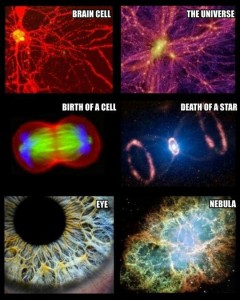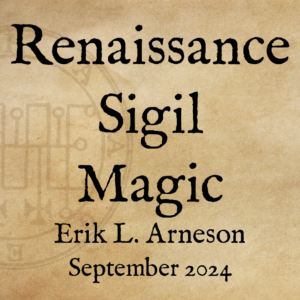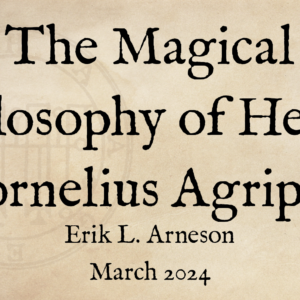 The most well-known saying from Hermeticism is the Hermetic axiom, “As above, so below.” This is a simplified version of a verse from the Emerald Tablet, which states:
The most well-known saying from Hermeticism is the Hermetic axiom, “As above, so below.” This is a simplified version of a verse from the Emerald Tablet, which states:
That which is below is like that which is above & that which is above is like that which is below to do the miracles of one only thing.1
What does this enigmatic statement mean? It is an expression of an idea which is found across religions and spiritual traditions. It metaphorically explains the way that the microcosm, or the physical and spiritual world which we inhabit, mirrors the macrocosm, or the larger scope of the Cosmos and even God.
The microcosm encompasses you as an individual and the observable world around you. It can also encompass the comprehensible world, which would include everything that can be directly or indirectly observed through any method available to you. In this sense, the microcosm encompasses not only your immediate world, but everything in the Universe that we can look at, predict, or attempt to explain through scientific observation.
This doesn’t seem to leave much room for the macrocosm. In some sense, the macrocosm can be viewed as a collective of all elements of the microcosm. But it can also represent a sort of divine blueprint, the plan by which creation occurs and the Cosmos continues to happen. The Hermetic axiom reflects a belief that everything in the microcosm reflects an element of the divine plan, but it also means that changes in the microcosm also cause or reflect changes in the divine plan.
Repeating Patterns in Nature
 The Emerald Tablet was written long ago, when our concept of the Universe was limited in scope. Centuries after it was written, we began to realize that the actual physical Universe wasn’t limited to a finite set of nested spheres. It is much, much greater than that. Mystics and philosophers like Nicholas of Cusa and Giordano Bruno began to teach that the Cosmos was infinite, and that each star in the sky was another Sun like our own.
The Emerald Tablet was written long ago, when our concept of the Universe was limited in scope. Centuries after it was written, we began to realize that the actual physical Universe wasn’t limited to a finite set of nested spheres. It is much, much greater than that. Mystics and philosophers like Nicholas of Cusa and Giordano Bruno began to teach that the Cosmos was infinite, and that each star in the sky was another Sun like our own.
The concept of an infinite Cosmos continues to be challenging to the imagination. It fascinated many. Benjamin Franklin wrote about it over a century after Bruno’s death.
Also, when I stretch my Imagination thro’ and beyond our System of Planets, beyond the visible fix’d Stars themselves, into that Space that is every Way infinite, and conceive it fill’d with Suns like ours, each with a Chorus of Worlds for ever moving round him, then this little Ball on which we move, seems, even in my narrow Imagination, to be almost Nothing, and my self less than nothing, and of no sort of Consequence.2
In the infinite Cosmos, we see patterns repeating over and over, providing a boggling continuity of correspondence, from microcosm to macrocosm repeatedly. As modern science continues to show us both the smallest and largest of things, the patterns become amazing and overwhelming. This is a second interpretation of the Hermetic axiom: “That which is below is like that which is above.”
Learning More
The concept of microcosm and macrocosm is complicated, and it’s worth studying further. It is related to the Platonic concept of ideas and forms, and is reflected in early Christian Gnostic writings, as well. In my earlier article on the Emerald Tablet, I shared a quote from the Gospel of Philip which seems to echo the Hermetic axiom. However, also consider the line from the Lord’s Prayer, “Thy kingdom come, Thy will be done in earth, as it is in heaven.”3 The concept of reflection between the upper world and our own is pervasive throughout religion and philosophy, and is a fascinating target for further contemplation and meditation.
 I will close this article with a quote from Heinrich Cornelius Agrippa, one of the greatest Renaissance philosophers, who wrote:
I will close this article with a quote from Heinrich Cornelius Agrippa, one of the greatest Renaissance philosophers, who wrote:
Divinity is annexed to the mind, the mind to the intellect, the intellect to the intention, the intention to the imagination, the imagination to the senses, the senses at last to things.
For this is the band, and continuity of nature, that all superior virtue doth flow through every inferior with a long, and continued series, dispersing its rays even to the very last things; and inferiors through their superiors, come to the very Supreme of all. For so inferiors are successively joined to their superiors, that there proceeds an influence from their head, the first cause, as a certain string stretched out, to the lowermost things of all, of which string if one end be touched, the whole doth presently shake, and such a touch doth sound to the other end, and at the motion of the inferior, the superior also is moved, to which the other doth answer, as strings in a Lute well tuned.4
From Isaac Newton’s translation of the Emerald Tablet, c. 1680. ↩
Franklin, Benjamin. “Articles of Beliefs and Acts of Religion.” The History Carper. Accessed March 11, 2016. http://www.historycarper.com/1728/11/20/articles-of-beliefs-and-acts-of-religion/. Originally written November 20, 1728. ↩
Matthew 6:10, King James Version. ↩
Cornelius, Agrippa Von Nettesheim Heinrich. Three Books of Occult Philosophy. Edited by Donald Tyson. Translated by James Freake. St. Paul, MN, U.S.A.: Llewellyn, 1993. book I, chapter XXXVII. 110-1. ↩






[…] with his right hand, while pointing to the ground with his left. In doing so, he is symbolizing the Hermetic axiom found in the Emerald Tablet, which states, “That which is below is like that which is […]
[…] That which is below is like that which is above & that which is above is like that which is below to do the miracles of one only thing […]
Good info. Lucky me I recently found your site by accident (stumbleupon).
I have saved it for later!
[…] the HT, the Devil no longer makes an “As above, so below” sign with his […]
[…] block to our own advancement. He parodies the Magician, whose triumphant gesture reminds us of the Hermetic axiom, “That which is below is like that which is above & that which is above is like that […]